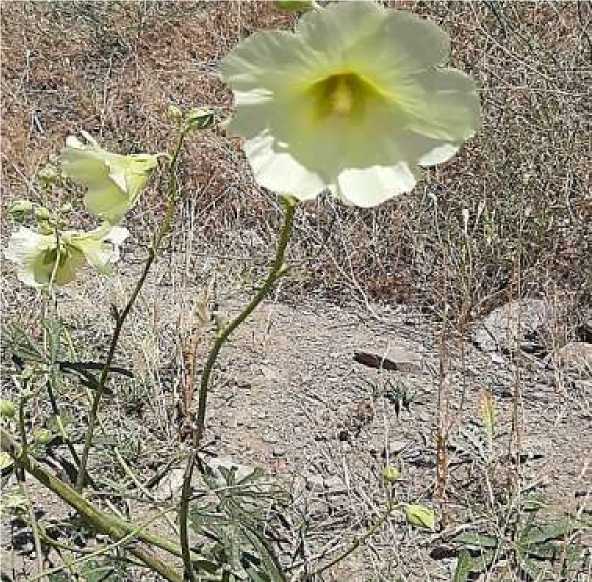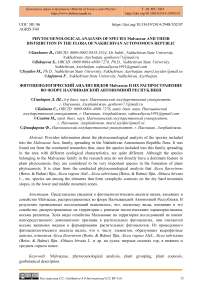Phytocoenological analysis of species Malvaceae and their distribution in the flora of Nakhchivan Autonomous Republic
Автор: Ganbarov D., Babayeva S., Seyidov M., Jafarova F.
Журнал: Бюллетень науки и практики @bulletennauki
Рубрика: Биологические науки
Статья в выпуске: 5 т.10, 2024 года.
Бесплатный доступ
Provides information about the phytocoenological analysis of the species included into the Malvaceae Juss. family, spreading in the Nakhchivan Autonomous Republic flora. It was found out from the conducted researches that, since the species included into this family spreading in the area with different ecological characteristics, are quite different. Although the species belonging to the Malvaceae family in the research area do not directly have a dominant feature in plant phytocenosis, they are considered to be very important species in the formation of plant phytocenosis. It is clear from the conducted phytocoenological analysis that Alcea flavovirens (Boiss. & Buhse) Iljin, Alcea rugosa Alef., Alcea tabrisiana (Boiss. & Buhse) Iljin, Althaea hirsuta L., etc. species are among the elements that form xerophytic coenosis on the dry hard mountain slopes, in the lower and middle mountain zones.
Malvaceae, phytocoenological analysis, plant grouping, plant coenosis, geobotanical description
Короткий адрес: https://sciup.org/14130471
IDR: 14130471 | УДК: 581.96 | DOI: 10.33619/2414-2948/102/07
Текст научной статьи Phytocoenological analysis of species Malvaceae and their distribution in the flora of Nakhchivan Autonomous Republic
Бюллетень науки и практики / Bulletin of Science and Practice
The geographical location of the Nakhchivan Autonomous Republic, relief features, soil and climate factors have led to the creation of special vegetation here. One of the main natural resources of this region is its rich vegetation. Numerous studies have been conducted to study the structure, composition and dynamics of the vegetation of the region. The formation of vegetation first of all begins within the phytocenosis itself. Then, the ongoing interactions between plants and the environment ensure the formation of phytocenosis. Plant groups are found in all landforms, water basins, slopes of river valleys and fields, ravines, high mountain slopes. Often these completely independent phytocenosis form the most diverse groupings. Obviously, this is due to both optimal soil-climatic conditions and strong of the terrain, which creates a large number of different ecotopes. Malvaceae species have their own place in the formation of regional vegetation, in the formation of various plant groups and in the enrichment of the species composition of this vegetation.
Research material and methodology
During the research, generally were used accepted floristic, geobotanical, bioecological, etc. methods, phenological observations and routes. As the main research materials, reference was made to the literature sources and actual data obtained during the field researches. Based on V. V. Alekhin’s methodology there have been used [1], B. A. Bykov, R. D. Yaroshenko [2, 6], Y. M. Lavrenko [4], L. I. Prilipko [5], A. Sh. Ibrahimov’s [3] and the works of other researchers.
Discussion and conclusions of the study
During field researches, there have been carried out the geobotanical descriptions of all the species including into the Malvaceae, family, and all vegetation where the species are spreading in the region, was determined by analyzing the obtained materials. Also, spreading of the Malvaceae family species in the plant formations formed by the species, their position in the formation was analyzed and the structure of the coenosis formed by these species was studied in a comparative manner. Since these plant species spread in the areas with different ecological characteristics, the characteristics of the plant coenosis in which they are included are quite different. In particular, the variety of rocky and gravelly areas where xerophytic elements spread, forest and forest edge areas where mesophytic elements spread, edges of agricultural fields, ditches and relatively humid areas means the variety of coenosis formed in these areas.
A florocenosis (plant community) is understood as a natural combination of developed species, which includes 1) relationships between species, 2) adaptations to the conditions of a certain environment, and 3) the history of a certain area and its flora.
Each sufficiently formed plant group has a certain floristic composition, structure and physiognomy. The plant species that make up the Nakhchivan Autonomous Republic flora, form different plant groups in the territory of the region.
The formation is characterized by common dominant and determinant species, but this is not characteristic of their entire range, but only in the part where phytocenotic and biogeographic relationships and corresponding ecological potential are maintained at a certain level. Identification of formations by dominants and determinants should be carried out within the groups and classes of formations, which ensures their structural and ecological commonality, as well as the necessary territorial localization. In this case, plant formation may include genetically and ecologically distinct plant groups.
With the dominant approach, syntaxons are distinguished according to the dominants of individual layers of plant groups.
The main unit of the dominant classification is the formation — the sum of associations formed on the basis of one dominant (for example, the formation of oak forests) and dominants of different layers. This approach is simple and fully applicable where there are several distinct dominants with strong structural features in the grouping, and the vegetation is highly discrete.
However, this approach cannot be applied to the vegetation classification of meadows, steppe vegetation, sparse and burned areas, where the dominant species can change rapidly in different years and even seasons, and which have weak structural characteristics that cause great variability in the species composition of groups, and the vegetation is characterized by discontinuity and extreme characterized by durability. Therefore, the floristic approach is becoming more and more widespread.
The plant association is the main classification unit of plant groups, a set of homogeneous phytocenosis with the same structure, species composition, and similar relationships between organisms and their environment. Each plant group is associated with certain ecological conditions: climate, soil, as well as the animal world that lives there. It is characterized by a certain productivity (reserve and growth) of the plant mass.
Based on all these indicators, we were able to determine the groupings of coenosis formed with the participation of species of the Malvaceae family. In fact, the species included in the Malvaceae family do not directly have a dominant feature in the plant phytocenosis, but they are very important species in the formation of plant phytocenosis. Alcea flavovirens (Boiss. & Buhse) Iljin, Alcea rugosa Alef., Alcea tabrisiana (Boiss. & Buhse) Iljin, Althaea hirsuta L., etc. species are among the elements that form xerophytic coenosis on the dry hard mountain slopes in the lower and middle mountain.

Figure. Coenosis formed by the species Alcea rugosa
These plants are part of the Cereal — various grassed xerophyte type formations formed in these areas. In addition to the species indicated in these groupings, Trisetum rigidum (M. Bieb.) Roem. & Schult., Bromopsis variegata (M. Bieb.) Holub, Phleum phleoides (L.) H. Karst., Koeleria bitczenachica (Tzvelev) Tzvelev, K. albovii Domin, Dactylis glomerata L., Poa bulbosa L. Ziziphora rigida (Boiss.) Heinr. Braun, Centaurea squarrosa Willd., Thymus kotschyanus Boiss. & Hohen., Th. collinus M. Bieb., Scutellaria sevanensis Sosn. ex Grossh., Teucrium polium L., T. orientale L., Nepeta trautvetteri Boiss. & Buhse and leguminous species such as Astragalus euoplus , A. lagurus Willd., Medicago caerulea Less. The main dominant elements of these groupings are the representatives of the Cereal types. Especially in the rocky and gravelly streams, species of Malvaceae family Astragalus lagurus , Prunus fenzliana , Scrophularia variegata , Dianthus orientalis , Nepeta trautvetteri, Asperula glomerata, Michauxia laevigata, etc. are included into the coenosis formed by plants [7-11].
Malva aegyptia L. aggr. M. iljinii I. Riedl and in the composition of the xerophytic plants in the semi-desert area, are included into the composition of various herbaceous formations that are characteristic for these areas.
The mesophytic species Dagestan phloem Althaea armeniaca Ten. ( Althaea daghestanica L.), hemp-like phloem ( Althaea cannabina L.) species form groups with large plantains and various types of mesophytic plants in relatively humid areas, in yards and orchards.
Althaea rosea L. and Althaea officinalis L. forms groups of different composition in forest edges and forest clearings. These groups include Anthriscus sylvestris Hoffm., Astrantia maxima Pall., Poa nemoralis L., Dactylis glomerata , Campanula latifolia , Delphinium szowitsianum Boiss., Primula macrocalyx Bunge, Poa pratensis , Ornithogalum ponticum , Lotus corniculatus , L. tenuis Waldst. & Kit. Ex Willd, Trifolium pratense , T. canescens , Vicia elegans Guss., Gladiolus kotschyanus , Phleum phleoides , Alopecurus armenus (K. Koch) Grossh., Lathyrus miniatus , Chaerophyllum aureum L., Ch. macrospermum (Willd ex Spreng.) Fish. & C. A. Mey., Malva neglecta Wallr., Malva sylvestris L., etc. species are included, and they form equal groups with other types of weeds.
6 species of the Malvaceae family are planted and propagated as decorative and technical plants. Although some species, especially Chinese rose ( Hibiscus rosa-sinensis L.), Syrian hibiscus ( Hibiscus syriacus L.), Pont hibiscus ( Hibiscus ponticus Rupr.), Kanaf hibiscus ( Hibiscus cannabinus L.), are planted as decorative plants, Abelmoschus esculentus (L.) Moench-Edible okra is propagated as a food plant. Gossypium hirsutum L. — as in other countries of the world, Uplag cotton is planted and propagated as a technical plant in large areas in the form of agrocenosis, covering large areas.
However, it should be noted that these phytocenosis are very rare in different areas, and as a result of long-term grazing, the species in these phytocenosis are eaten without producing fruits and seeds, so they gradually continue to disappear. Important plant species such as the medical, technical, food, etc. types included into the composition, are gradually disappearing and it is very difficult to restore these phytocenosis.
Conclusions
It is clear from the conducted phytocoenological analysis that Alcea flavovirens , Alcea rugosa, Alcea tabrisiana, Althaea hirsuta , etc. belonging to the Malvaceae family in the study area. Such species are considered to be species that form xerophytic coenosis on dry hard mountain slopes in the lower and middle mountain zones.
Список литературы Phytocoenological analysis of species Malvaceae and their distribution in the flora of Nakhchivan Autonomous Republic
- Alekhin, V. V. (1950). Geografiya rastenii (osnovy fitogeografii, ekologii i geobotaniki). Moscow. (in Russian).
- Bykov, B. A. (1965). Dominanty rastitel'nogo pokrova Sovetskogo Soyuza. Alma-Ata. (in Russian).
- Ibragimov, A. Sh. (2007). Rastitel'nost' Nakhchyvanskoi Avtonomnoi Respubliki, ee proizvoditel'nost' i botaniko-geograficheskoe raionirovanie: Avtoref. … d-r biol. nauk. Baku, 8-34. (in Russian).
- Lavrenko, E. M. (1959). Osnovnye zakonomernosti rastitel'nykh soobshchestv i puti ikh izucheniya. In Polevaya geobotanika, Moscow, 1, 13-75. (in Russian).
- Prilipko, L. I. (1939). Rastitel'nye otnosheniya v Nakhichevanskoi ASSR. Baku, (in Russian).
- Yaroshenko, P. D. (1967). K metodike opredeleniya vesa travostoev po vysote osnovnoi massy i proektivnomu pokrytiyu. Botanicheskii zhurnal, (4), 27-31. (in Russian).
- Ganbarov, D., & Babayeva, S. (2022). Floristic Analysis of the Distribution of the Crataegus L. Genus in the Mountain Xerophyte and Steppe Vegetation of Nakhchivan. Bulletin of Science and Practice, 5(10), 27-33. https://doi.org/10.33619/2414-2948/83/02
- Ganbarov, D. S., & Ibrahimov, A. S. (2015). Astragalus dasyanthus L. (Fabaceae), a new species to the flora of Azerbaijan. International Journal of Multidisciplinary Research and Development, 2(1), 426-427.
- Ganbarov, D., Aslanova, E., & Abbasov, N. (2023). New Location of the Species Astragalus mollis M. Bieb. (Fabaceae) in the Flora of Nakhchivan (Azerbaijan). Bulletin of Science and Practice, 9(11), 75-79. (in Russian). https://doi.org/10.33619/2414-2948/96/08
- Ganbarov, D., & Babayeva, S. (2020). Systematical Structure, Geographical Areal Classes and Ecological Groups of Rosa L. Genus Spreading in the Flora of Nakhchivan Autonomous Republic. Bulletin of Science and Practice, 6(6), 55-60. https://doi.org/10.33619/2414-2948/55/07
- Ganbarov, D. Sh., Ibragimov, A. Sh., & Nabieva, F. Kh. (2018). Dva novykh astragala dlya flory Nakhichevanskoi Avtonomnoi respubliki Azerbaidzhana. Vestnik nauki i obrazovaniya, 1(3 (39)), 17-21. (in Russian).


